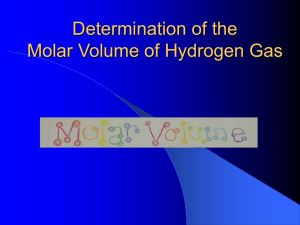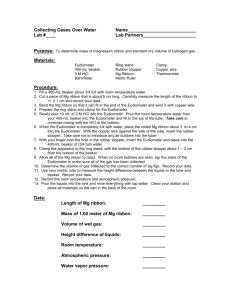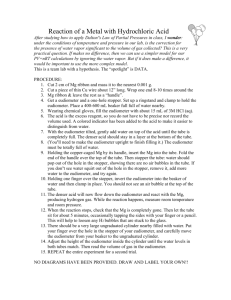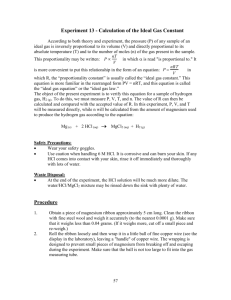EXPERIMENT 18:
advertisement
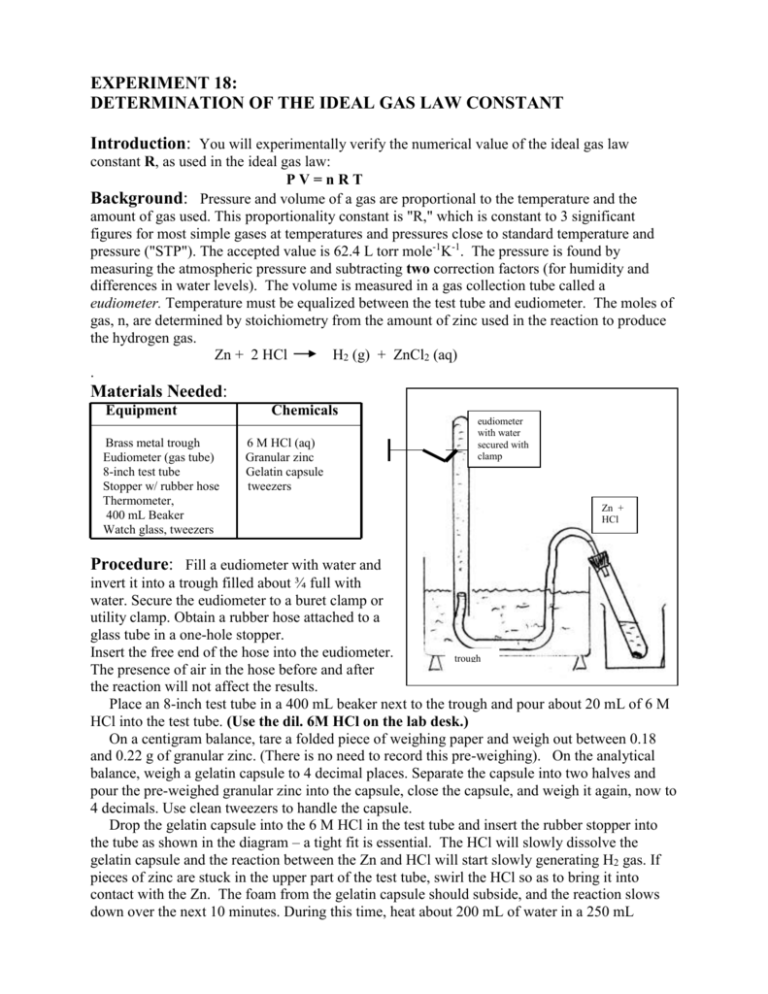
EXPERIMENT 18: DETERMINATION OF THE IDEAL GAS LAW CONSTANT Introduction: You will experimentally verify the numerical value of the ideal gas law constant R, as used in the ideal gas law: PV=nRT Background: Pressure and volume of a gas are proportional to the temperature and the amount of gas used. This proportionality constant is "R," which is constant to 3 significant figures for most simple gases at temperatures and pressures close to standard temperature and pressure ("STP"). The accepted value is 62.4 L torr mole-1K-1. The pressure is found by measuring the atmospheric pressure and subtracting two correction factors (for humidity and differences in water levels). The volume is measured in a gas collection tube called a eudiometer. Temperature must be equalized between the test tube and eudiometer. The moles of gas, n, are determined by stoichiometry from the amount of zinc used in the reaction to produce the hydrogen gas. Zn + 2 HCl H2 (g) + ZnCl2 (aq) . Materials Needed: Equipment Brass metal trough Eudiometer (gas tube) 8-inch test tube Stopper w/ rubber hose Thermometer, 400 mL Beaker Watch glass, tweezers Chemicals 6 M HCl (aq) Granular zinc Gelatin capsule tweezers eudiometer with water secured with clamp Zn + HCl Procedure: Fill a eudiometer with water and invert it into a trough filled about ¾ full with water. Secure the eudiometer to a buret clamp or utility clamp. Obtain a rubber hose attached to a glass tube in a one-hole stopper. Insert the free end of the hose into the eudiometer. trough The presence of air in the hose before and after the reaction will not affect the results. Place an 8-inch test tube in a 400 mL beaker next to the trough and pour about 20 mL of 6 M HCl into the test tube. (Use the dil. 6M HCl on the lab desk.) On a centigram balance, tare a folded piece of weighing paper and weigh out between 0.18 and 0.22 g of granular zinc. (There is no need to record this pre-weighing). On the analytical balance, weigh a gelatin capsule to 4 decimal places. Separate the capsule into two halves and pour the pre-weighed granular zinc into the capsule, close the capsule, and weigh it again, now to 4 decimals. Use clean tweezers to handle the capsule. Drop the gelatin capsule into the 6 M HCl in the test tube and insert the rubber stopper into the tube as shown in the diagram – a tight fit is essential. The HCl will slowly dissolve the gelatin capsule and the reaction between the Zn and HCl will start slowly generating H2 gas. If pieces of zinc are stuck in the upper part of the test tube, swirl the HCl so as to bring it into contact with the Zn. The foam from the gelatin capsule should subside, and the reaction slows down over the next 10 minutes. During this time, heat about 200 mL of water in a 250 mL beaker to boiling. After ten minutes, pour the boiling water into the 400 mL beaker where the test tube is sitting. This will speed the reaction. Let the test tube sit in the hot water until the reaction stops (all the Zn is dissolved). After the reaction stops, place the test tube in the metal trough carefully, and allow the temperature to equilibrate. With a ruler, measure the distance in mm from the surface of the water (h) in the trough to the level of the water in the eudiometer. Obtain the barometric pressure (instructor will instruct you on the proper use of a barometer). Measure the volume of gas collected in the tube after the temperature has equilibrated. Measure the temperature of the water in the trough. (This is the T of the gas). Amadeo Avogadro (1776-1856). His hypothesis in 1811 that equal volumes of gases at constant temperature and pressure, contained equal numbers of particles, was not generally accepted until 1860 at a great convention of chemists when his countryman the great chemist S. Cannizzarro, presented the idea and it came to be accepted. Too late for Avogadro – who had already passed away. Name: _____________________________ EXPERIMENT 18: REPORT THE IDEAL GAS LAW CONSTANT Section: _________ Data and Calculations: Run 1 mass of capsule with zinc ............... Run 2 ____________________________ mass of capsule ............................... ____________________________ mass of zinc .................................... ____________________________ volume of gas in eudiometer............ ____________________________ L (convert mL to L) temperature, Kelvin (oC + 273) …. ____________________________ K moles of zinc used = moles H2 ....... ____________________________ mol Barometric pressure (mm Hg or torr) ...... _________________________mm Hg (mm Hg is same unit as torr – instructor will provide this value) height of water (h) in gas tube…….. Vapor pressure………………… ____________________________ mm H2O (at the oC temperature of the water; found in a table in the CRC Handbook) ___________________________ mm Hg * this is Calculation of pressure of H2: First, convert the height difference of the water levels in the eudiometer, h, from mm H2O to mm Hg by dividing by 13.6 (the density of Hg). height of H2O / 13.6 = _____________ ___________ mm Hg ** (run 1) (run 2) Then, subtract both the vapor pressure (*), and the converted water pressure difference (**) from the barometric pressure to obtain the actual pressure of dry hydrogen. This is the value that will be used in the ideal gas law. PH2 = PBar - mmHg* - mmHg** (vapor P) (height / 13.6) = _______________ _______________ mm Hg (run 1) (run 2) Calculation of R: Using PV = nRT, calculate R from each run. Set this up on a separate sheet of paper – attach to report. R= mean experimental value of R (include the units) _______ ________ run1 run 2 __________________ Conclusions and Questions: 1. Compare your mean value for R to the accepted value of 62.4 L-torr/mol-K. Calculate the % error. ______________% error 2. Try to explain why the % error may be high or low – i.e. what systematic factors in the experiment itself may lead to an answer that is not exactly correct. (Do not include student errors such as "I forgot to set the balance to 0 “, etc. We assume the student is a perfect experimenter and errors result only from the experiment itself.) Think about how the T and V were measured. 3. Using your mean experimental value of R, and a value of n = 1.00, calculate the molar volume of your H2 at STP (standard T = 273 K, P = 760 mm Hg), using the ideal gas law. 4a) Why are two correction factors subtracted from the barometric pressure? 4b) If you had not used the correction factors, what would your calculated value of R have been?

